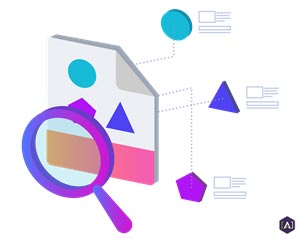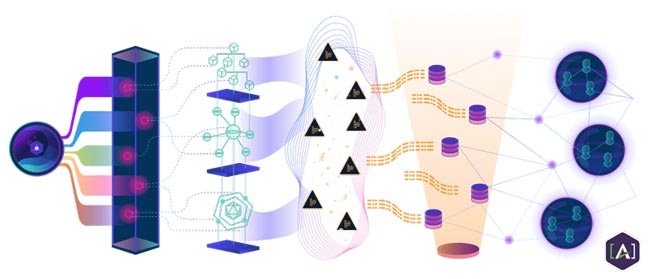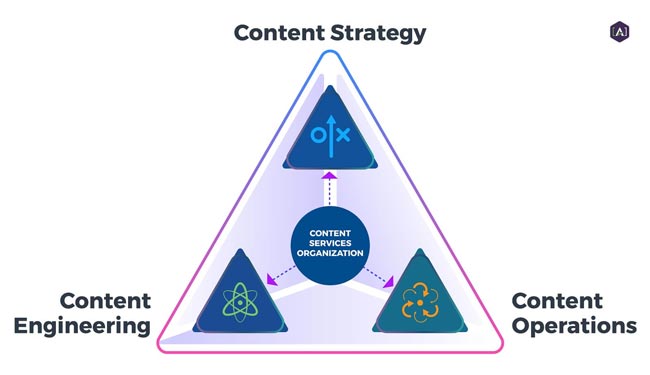Join [A]’s Founder and Principal, Cruce Saunders, as he answers questions on Information Architecture. In this written interview, we explore the impact of information architecture practices and how they connect to the larger Intelligent Content ecosystem.
What is your definition of Information Architecture?
So in this new world of content-driven customer experience, the denominator is information, and the nature of that information is evolving. It used to be that a consumption event for information was a single, static instance of a publication - mainly paper - and that could be a book, that could be a pamphlet, that could be a brochure that came in the mail, a letter. Eventually, what was mainly paper could be delivered as a web page.


It could be different kinds of information delivered in some static form, like PDF. Someone may be shifting towards modularization: the component-based reuse of content assets. So, content requires thought in order for it to be intelligently reused. When I think of
information architecture, I'm thinking not just about the organization of the information within its presentation environment. The content must be understood in a semantic sense, but also the way that content is inherently organized at a structural level for its portability and reuse should be understood.
So, when I think of information architecture, I do think about that entire spectrum from an information organization, and its various formats of organization, as well as its potential reader comprehension. So its ability to connect meaning to readers and their context, and then also the physical organization and structure of the content for modular reading - which are both very important.
What kind of methodology do you employ in the pursuit of information architecture?
Well, the nature of information is so inherently diverse that it usually resists a strong methodological approach. I agree that information mapping and its exponents are an important methodology to include in the consideration of a body of content in an enterprise. This can be a useful lens to see the full scope of how comprehensible a domain of content is.
I really appreciate the methodology and its application because it's essentially the nature of most communication. It is evolving towards scalability, readability, organization, digestibility in a human or a brain-oriented way.
So, that is one methodology that I'm familiar with and comfortable with recommending. Although I am not an expert in this myself, by any stretch of the imagination. And I am very comfortable needing to address that we want to sort of upgrade the content itself along the way, as part of the lifecycle from one static set of content into a modular, usable form.

Here at [A], we created our own kind of framework to help clients understand some of the different dimensions of content. We actually “story-organize” the information from a structural and a semantic standpoint. So, we look at those dimensions of content along with many other variables.

There are public methodologies like information mapping that are very good starting points to understand content sites.
Can you explain the distinction between the user experience, world versus the technical communication world? Why are they separate and how can we bring them together?

Yeah, there's a lack of integrated thinking within the industry about the various practices and their disciplines. It will be incumbent upon all of us in the industry over the next 5-10 years to really engage in a shared dialogue about these roles and how they play out within discipline and practice. We have created a landscape that covers strategy, engineering, and operations as the continuum of major patterns that we see interacting with content. And within those, there are just a lot of overlapping dimensions.

We end up seeing this within Content Strategy as well. If you ask 10 random Content Strategists what they do and how they describe their job, the answers will be pretty different. I think this is part of the nature of information architecture.
If you're talking to some about what IA is versus what UX is, it's a different conversation than if you're talking to a UX pro, like an interface designer like Ethan Marcotte, or someone like that. There is an understanding overlap, but they're not the same focus of Content Strategy.
Kristina Halvorson recently started a whole new conference that's coming out called Button, which is just dealing with other aspects of interface design that are content-driven. Her Content Strategy conference has had heavy, heavy emphasis on content design recently, and I think Shopify just changed their Content Strategy practice to a kind of design practice. So there's this shift moving about what each of these things is called and what's included.


I believe that we need to have a common conversation at some point because what's happening right now is there's sort of this freeform definition. What ends up happening because of that is everybody kind of does their own thing and it diminishes the value of that practice for enterprise buyers.
If everybody is calling themselves an “X” and the X isn't consistent, it's not meaningful. But in other trades, there are more commonly understood practices, disciplines, and some level of maturity to how we define all of those things, based on equality within all of the various accomplishments within those areas. I don't think the content industry has any of that maturity yet, but I think we have to develop it.
In this ever-changing landscape, where do you see the industry going?
Yeah, I think there's going to be a continued kind of proliferation of titles and roles, practices, and disciplines until we're able to basically get together and begin to share a meaningful dialogue about how the practices and discipline shake out. There are attempts to create a
taxonomy that I've seen floating around. So I think Sarah Feldman’s was the last one I saw. There are sidebar conversations that a lot of us in the industry have about these issues.
I think sometimes, [A] and Precision Content and some of the other vendors in the space should at least get together and have a conversation on the telecom side about roles, relationships. And then I think maybe we could extend an olive branch out to some of the folks on the UX side and start to create a common conversation with them. Then we can reach out together to the designers and try to create a common conversation with them, because digital doesn't get done without lots of different kinds of people. Everybody, because they're so unique, has a different take on when they say user experience, or when they say
information architecture what they mean.
And that's all fine. We need that diversity. We're talking about the representation of human experience. So it's as diverse as humans are.
But that's not to say we can't meet and come up with some agreed-upon definitions and a map of how those definitions relate so that we can begin to also collectively chart how we deliver value through those practices.
I absolutely believe the definitions in our space need this kind of discussion writ large in order to drive value for businesses because the service-provider industry is delivering value into a diverse set of roles and practices inside the enterprise as well. And our counterparts on the inside right, the information architects on the inside,
Content Engineering on the inside, the people that are strategists on the inside of those companies. All are fighting for their own reason to exist.
Why? With content, we're dealing with a lot of invisible stuff. And so why does anybody get to keep their job and keep growing their value to that organization and getting promotions? There has to be a business justification and that has to be built on something that has a sort of shared understanding of the work, what it’s performing, and the value it's performing for the business.
Does anything else come to mind in terms of patterns to recognize?
Certainly having an ability to deal with the complexity of content, a large, large body of content, and find the inherent, usable patterns. And to be able to find those patterns within that content on the basis of business value.
There are certainly patterns to be found in terms of content that can be made available in different formats. So, which of these experiences can be translated into different kinds of surfaces, different kinds of interaction formats, be it voice or other kinds of interactions that are emerging? There's not just the explicit content. We also need to be able to find what the content is trying to say … its underlying Semantic meaning.
Within
Information Architecture, there's a tremendous opportunity. I think it's one of the most amazing professions because it gives one the ability to look into the heart of knowledge and bring that out in a way that can connect with the most people in the most effective way so that the content can perform its work.
Knowledge can perform its work in the world, so the Information Architect connects that invisible stuff with humans. That's a beautiful and noble thing to do, in my view.
Further reading and resources
For more on how Information Architecture and Knowledge Management are evolving within organizations, download the
[A] Guide to Creating Content-as-a-Service through smart Knowledge Management practices.
And for more on how the different Content roles and practices work together, download the
[A] Guide to the Content Services Organization
Contact Us for a Free Consultation.